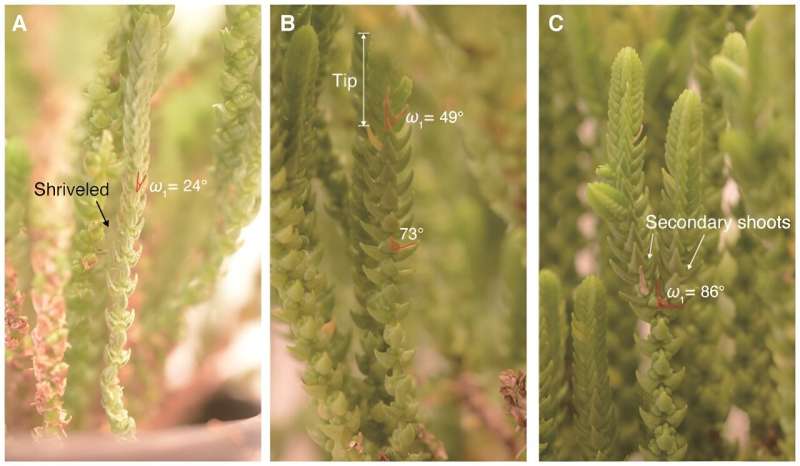This article has been reviewed according to Science X's editorial process and policies. Editors have highlighted the following attributes while ensuring the content's credibility:
fact-checked
peer-reviewed publication
trusted source
proofread
Study reveals the mechanism of bio-inspired control of liquid flow

The more we discover about the natural world, the more we find that nature is the greatest engineer. Past research believed that liquids can only be transported in fixed direction in species with specific liquid communication properties, and they cannot switch the transport direction.
Recently, Hong Kong Polytechnic University (PolyU) researchers have shown that an African plant controls water movement in a previously unknown way—and this could inspire breakthroughs in a range of technologies in fluid dynamics and nature-inspired materials, including applications that require multistep and repeated reactions, such as microassays, medical diagnosis and solar desalination, etc.
The study has been published in the journal Science.
Liquid transport is an unsung miracle of nature. Tall trees, for example, have to lift huge amounts of water every day from their roots to their highest leaves, which they accomplish in perfect silence. Some lizards and plants channel water through capillaries. In the desert, where making the most of scarce moisture is vital, some beetles can capture fog-borne water and direct it along their backs using a chemical gradient.
Scientists have long sought to hone humankind's ability to move liquids directionally. Applications as diverse as microfluidics, water harvesting, and heat transfer depend on the efficient directional transport of water, or other fluids, at small or large scales.
Although the above-mentioned species provide nature-based inspiration, they are limited to moving liquids in a single direction. A research team led by Prof. Wang Liqiu, Otto Poon Charitable Foundation Professor in Smart and Sustainable Energy, Chair Professor of Thermal-Fluid and Energy Engineering, Department of Mechanical Engineering of PolyU, has discovered that the succulent plant Crassula muscosa, native to Namibia and South Africa, can transport liquid in selected directions.
Together with colleagues from the University of Hong Kong and Shandong University, the PolyU researchers noticed that when two separate shoots of the plant were infused with the same liquids, the liquids were transported in opposite directions.
In one case, the liquid traveled exclusively towards the tip, whereas the other shoot directed the flow straight to the plant root. Given the arid but foggy conditions in which C. muscosa lives, the ability to trap water and transport it in selected directions is a lifeline for the plant.
As the shoots were held horizontally, gravity can be ruled out as the cause of the selective direction of transport. Instead, the plant's special properties stem from the tiny leaves packed onto its shoots.
Also known as "fins," they have a unique profile, with a swept-back body (resembling a shark's fin) tapering to a narrow ending that points to the tip of the plant. The asymmetry of this shape is the secret to C. muscosa's selective directional liquid transport. It all has to do with manipulating the meniscus—the curved surface on top of a liquid.
Specifically, the key lies in subtle differences between the fin shapes on different shoots. When the rows of fins bend sharply towards the tip, the liquid on the shoot also flows in that direction. However, on a shoot whose fins—although still pointing at the tip—have a more upward profile, the direction of movement is instead to the root.
The flow direction depends on the angles between the shoot body and the two sides of the fin, as these control the forces exerted on droplets by the meniscus—blocking flow in one direction and sending it in the other.
Armed with this understanding of how the plant directs liquid flow, the team created an artificial mimic. Dubbed CMIAs, for "C. muscosa-inspired arrays," these 3D-printed fins act like the tilted leaves of C. muscosa, controlling the orientation of liquid flow.
Cleverly, while the fins on a natural plant shoot are immobile, the use of a magnetic material for artificial CMIAs allows them to be reoriented at will. Simply by applying a magnetic field, the liquid flow through a CMIA can be reversed.
This opens up the possibility of liquid transport along dynamically changing paths in industrial and laboratory settings. Alternatively, flow could be redirected by changing the spacing between fins.
Numerous areas of technology stand to benefit from CMIAs. Prof. Wang said, "There are applications of real-time directional control of fluid flow in microfluidics, chemical synthesis, and biomedical diagnostics. The biology-mimicking CMIA design could also be used not just for transporting liquids but for mixing them, for example in a T-shaped valve.
"The method is suited to a range of chemicals and overcomes the heating problem found in some other microfluidic technologies."
More information: Ling Yang et al, Selective directional liquid transport on shoot surfaces of Crassula muscosa, Science (2024). DOI: 10.1126/science.adk4180
Journal information: Science
Provided by Hong Kong Polytechnic University





















